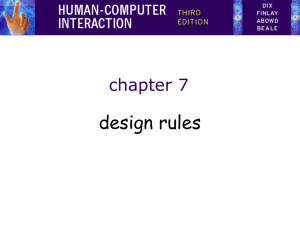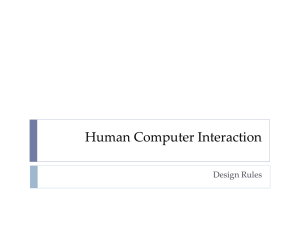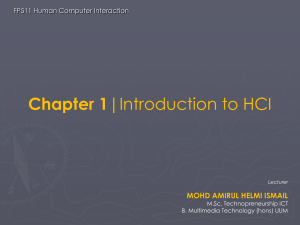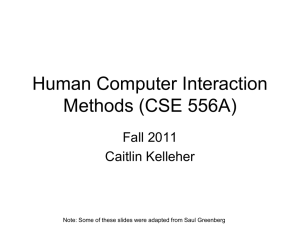Intronew
advertisement
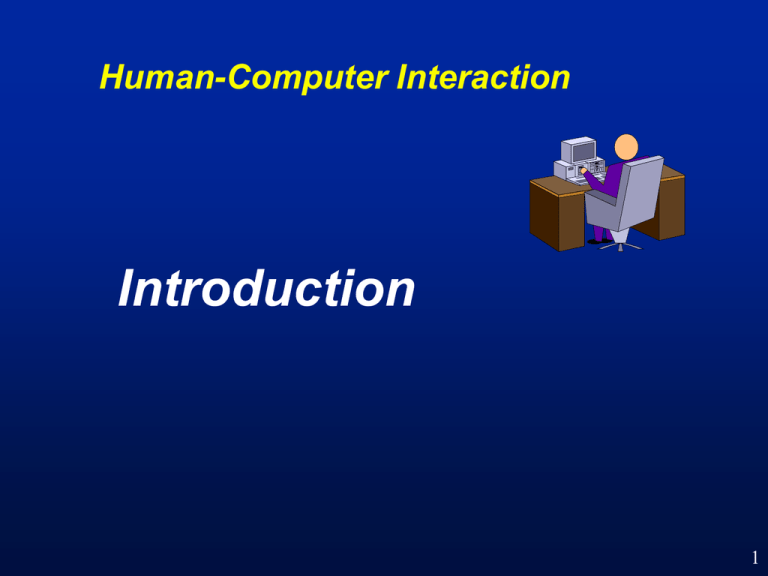
Human-Computer Interaction Introduction 1 Human-Computer Interaction: Aims • Knowledge of HCI • Some practical analysis and design skills • Practical implementation of GUIs • Enable you to assess how HCI may be incorporated into software lifecycle • Personal transferable skills 2 Lecture Overview • Background and aims of HCI • Usability • Rise in importance of • Interactive Systems • Graphical User Interface (GUI) 3 Human Computer Interaction - HCI Association for Computing Machinery (ACM) defines human-computer interaction as "a discipline concerned with the design, evaluation and implementation of interactive computing systems for human use and with the study of major phenomena surrounding them.” Goal of HCI Basic goal of HCI is to improve interactions between users and computers by making computers more usable and receptive to user's needs. Specifically, HCI is concerned with: • methodologies and processes for designing interfaces (i.e., given a task and a class of users, design best possible interface within given constraints, optimising for a desired property such as learnability or efficiency of use) • methods for implementing interfaces (e.g. software toolkits and libraries; efficient algorithms) • techniques for evaluating and comparing interfaces • developing new interfaces and interaction techniques • developing descriptive and predictive models and theories of interaction Course Outline: HCI and the Software Lifecycle User object modelling System design spec. (inc. Interface design spec.) User’s conceptual model design / Interaction style Interaction design / Presentation design Design U s e r P a r t i ci p a t i o n Requirements spec. (inc. usability specs.) Analysis Systems Analysis (inc. user and task analysis) Definition Problem statement Prototype (inc. online help) Evaluation (Analytical, Empirical) Implementation 6 The Parts of User Interface Development Development of the User Interface Behavioural Constructional Development of the interaction component Development of the interface software 7 Disciplines Contributing to Human Computer Interaction Computer Science Artificial Intelligence Sociology Cognitive Psychology Human Computer Interaction Graphic Design Ergonomics and Human Factors Central Aim and Approach of HCI Aim: To optimise performance of human and computer together as a system Approach: User-Centred • Users should not have to adapt to the interface: the interface should be intuitive and natural for them to learn and to use. • “Talking to users is not a luxury, it’s a necessity” 9 User Centred Design Work People Technology Environment 10 User Centred Design • User-Centred Design (UCD) or Pervasive Usability is a design philosophy and a process in which needs, wants, and limitations of end users of a product are given extensive attention at each stage of design process. • UCD can be characterized as multi-stage problem solving process that not only requires designers to analyse and foresee how users are likely to use a product, but also to test the validity of their assumptions with regards to user behaviour in real world tests with actual users. • Chief difference from other product design philosophies is that UCD tries to optimise the product around how users can, want, or need to use the product, rather than forcing the users to change their behaviour to accommodate the product. User Centred Design Principles • Early focus on users and tasks • Structured and systematic information gathering (consistent across the board) • Designers trained by experts before conducting data collection sessions • Empirical Measurement and testing of product usage • Focus on ease of learning and ease of use • Testing of prototypes with actual users • Iterative Design • Product designed, modified and tested repeatedly. • Allow for the complete overhaul and rethinking of design by early testing of conceptual models and design ideas. Software Quality (ISO 9126) • • • • • • Functionality Reliability Usability Efficiency Maintainability Portability 13 Requirements Gathering User Requirements Functional Data Usability Learnability Throughput Flexibility Attitude 14 Usability Bailey’s Human Performance Model Usability For specified user and specified task • Learnability • Ease of learning • User retention over time • Throughput • High speed of user task performance • Low user error rate • Flexibility • Freedom of object / action selection • User expertise levels • Attitude - subjective user satisfaction Usability Testing • • • • • • • • • • • Participatory Design Paper Prototyping / Storyboarding Cognitive Walkthroughs Usability Testing Heuristic Evaluation Usability Testing Focus Groups Participatory Design Surveys Heuristic Evaluation Set Benchmarks • • • • Usability Testing Heuristic Evaluation Follow-up Studies Compare To Benchmarks Source: Based Upon Rubin, et al. “Handbook of Usability Testing: How to Plan, Design, and Conduct Effective Tests” When It Goes Wrong Rubin et. al. * have identified five reasons why products, especially technology focused ones, are typically hard to use. These are: • Focus on the device or system during development • Changing and adapting target audience • Trivialising designing usable products • Non-integrated working of specialist teams both internally and with each other • Design and implementation does not always match. * “Handbook of Usability Testing: How to Plan, Design, and Conduct Effective Tests ” by Rubin, Chisnell and Spool Microsoft and Quicken • 1995 - Microsoft tries to purchase Quicken from Intuit for $1.5 billion • Reason for attempted purchase: Quicken more usable than Microsoft’s own product 19 Mitchell Kapor (Designer of Lotus 1-2-3) Quotes from A software Design Manifesto 1990 “The lack of usability in software and the poor design of programs are the secret shame of the software industry.” “One of the main reasons most computer software is so abysmal is that it’s not designed at all, but merely engineered….” “... implementors often place more emphasis on a program’s internal construction than on its external design.” (Reprinted in ‘Bringing Design to Software’, T. Winograd, 1996, Addison Wesley) 20 Usability Transparency Relationship between • • • user’s goals required actions results must be meaningful, not arbitrary 21 Problems with ATMs • Older people make much less use of ATMs • 24 year olds : average 7 visits to an ATM per month • Use drops off among those over 45 • 65+ years : two-thirds NEVER use an ATM • Senior citizens often put off by ATMs because they find the machines complicated, inconvenient and intimidating. • Buttons that didn’t line up with commands • Dimly lit screens hard to read in the glare of daylight • Sometimes confusing menu choices Source: http://cnn.com/TECH/9712/04/t_t/atms.seniors/index.html Reporting on research by W. Rogers and A. Fisk, Georgia Institute of Technology 22 Problems with ATMs (Continued) • Researchers and banks expected ATMs to be intuitively easy to use • Testing among senior citizens found only 20 percent correct operation • For example, one man tried to withdraw $30. He entered the amount he wanted incorrectly because the directions -- calling for "multiples of 10" -- confused him • Usability suggestions: • Simpler on-screen instructions • More "undo" buttons • Banks should provide training for any customers who need it • A "large percentage" of people they surveyed said they would use ATMs if trained 23 Example: Lack of Transparency Old UU phones: Call Diversion Instructions 24 Poor interface may cause: • Increased mistakes in data entry and system operation • Inaccessible functionality • User frustration: low productivity and/or under utilisation • System failure because of user rejection Nearly half of entire software development effort relates to the user interface. (Myers and Rosson, 1992) 25 Rise in Importance of Usability Research machines 1950s Mathematicians Scientists Machine reliability users do programming Mainframes 1960’s & 1970’s Data-processing professionals Users of output (business managers) grow disenchanted with delays, costs and lack of flexibility Minicomputers 1970’s Engineering and other non-computer professionals Users must still do must programming; usability becomes a problem Microcomputers 1980’s Almost anyone Usability is the major problem Shackle, 1991 26 ENIAC 1943: Research Machine (U.S. Army Photo) 27 IBM Mainframe 1960s (Photograph courtesy of the IBM archives) 28 Minicomputers: 1970s and 1980s U.S. Army Photograph, courtesy of Michael John Muuss, 29 Microcomputers: 1970s - 1990s 30 Desktop & Multimedia Internet Ready PCs Towards Pervasive / Ubiquitous Computing: 2005 - . . . 31 The Leading Trend in Software “Rise of GUI. The pervasiveness of graphical user interfaces is a clear sign that all software of the future must address the users’ needs for ease of use.” IEEE Software, Nov 1990 A very rich design medium 32 Browser the ‘New’ Graphical User Interface 33 Windows 8 – Pervasive Computing But Less Control 34 Benefits of GUIs over Text Interfaces • User completes tasks faster • Lower frustration e.g. • Less ‘modal’ operation • Easy interleaving tasks • Perceived lower fatigue • Better able to self-teach - Reduced training costs • Better able to learn more capabilities of applications 35 Recommended Further Reading Recommended Further Reading © Gary Larson Recommended Further Reading Advanced Common Sense SM http://www.sensible.com Lecture Review • • • • HCI and other subject areas User-centred Usability Faster CPUs / bigger disks support highly interactive systems • Interactive systems pervasive • Benefits of GUIs 39
